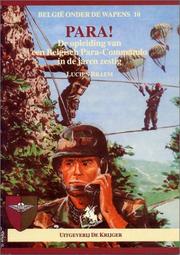| Listing 1 - 10 of 16 | << page >> |
Sort by
|
Book
Abstract | Keywords | Export | Availability | Bookmark
 Loading...
Loading...Choose an application
- Reference Manager
- EndNote
- RefWorks (Direct export to RefWorks)
Book

ISBN: 1598751689 Year: 2000 Publisher: Santa Monica, CA : RAND Corporation,
Abstract | Keywords | Export | Availability | Bookmark
 Loading...
Loading...Choose an application
- Reference Manager
- EndNote
- RefWorks (Direct export to RefWorks)
This work represents a compilation of research drawn from numerous studies on the topic of improving light air-deployable forces. The focus is on new operational concepts along with the underlying enabling technologies. Three different means for improving rapid-reaction capability are considered.
United States. --- Infantry. --- Airborne troops.
Book
Year: 1946 Publisher: Paris : Payot,
Abstract | Keywords | Export | Availability | Bookmark
 Loading...
Loading...Choose an application
- Reference Manager
- EndNote
- RefWorks (Direct export to RefWorks)
Airborne troops. --- Troupes aéroportées --- Germany. --- Parachute troops.
Book
Year: 1996 Publisher: Santa Monica, CA : Rand ;
Abstract | Keywords | Export | Availability | Bookmark
 Loading...
Loading...Choose an application
- Reference Manager
- EndNote
- RefWorks (Direct export to RefWorks)
In recent years, light, rapid-reaction forces have become a staple of U.S. military strategy and planning. Instead of defending predetermined regions with large, prepositioned forces, current U.S. plans call for quick and decisive deployments of lightly armed forces into locations of potential or actual hostilities. Equipping these forces with new or expected-to-be-developed hunter/killer capabilities -- a combination of standoff weapons, sophisticated reconnaissance and targeting systems, and efficient counterbattery weapons -- would greatly increase their lethality and survivability. Such an arsenal would be more effective than these forces' current firepower, which relies heavily on direct-fire, line-of-sight technologies, and would allow light forces to carry out the wider range of missions that military strategists have envisioned for them. These conclusions are supported by recent RAND research on the Rapid-Force Projection Initiative (RFPI), one of the Pentagon's new advanced-concept technology demonstrations. Using computer simulations, RAND analysts examined, compared, and contrasted new technologies and systems that would allow light forces to better withstand and overcome attacks from larger, more heavily armed forces in varying terrain. This documented briefing describes the simulation tools, the scenarios used for the analysis, and the findings resulting from the research. The simulation results suggest that a division ready brigade (DRB) can be improved to fight and survive against a current and future heavy force. The "hunter/standoff killer" concept, made possible by a number of emerging technologies, proved to be major contributor to the success of a DRB against a larger, more maneuverable heavy force. This briefing is a companion document to DB-169-A/OSD, Rapid Force Projection Technologies: A Quick-Look Analysis of Advanced Light Indirect Fire Systems, R. Steeb, J. Matsumura, et al., 1996
Weapons systems --- Computer simulation. --- United States. --- Airborne troops. --- Weapons systems.
Book
Year: 2011 Publisher: Carlisle, PA : Strategic Studies Institute, U.S. Army War College,
Abstract | Keywords | Export | Availability | Bookmark
 Loading...
Loading...Choose an application
- Reference Manager
- EndNote
- RefWorks (Direct export to RefWorks)
Organizational change --- Soviet Union. --- Russia (Federation). --- Airborne troops --- Reorganization.
Book
Year: 1946 Publisher: New York : Morrow,
Abstract | Keywords | Export | Availability | Bookmark
 Loading...
Loading...Choose an application
- Reference Manager
- EndNote
- RefWorks (Direct export to RefWorks)
Book
Year: 2015 Publisher: Fort Leavenworth, Kansas : The Army Press,
Abstract | Keywords | Export | Availability | Bookmark
 Loading...
Loading...Choose an application
- Reference Manager
- EndNote
- RefWorks (Direct export to RefWorks)

ISBN: 9072547624 Year: 1998 Volume: 10 Publisher: Erpe-Mere De Krijger
Abstract | Keywords | Export | Availability | Bookmark
 Loading...
Loading...Choose an application
- Reference Manager
- EndNote
- RefWorks (Direct export to RefWorks)
Polemology --- anno 1960-1969 --- Belgium --- Armée --- Belgique ; histoire --- België ; geschiedenis --- Leger --- Parachute troops --- Parachuters --- Parachutists --- Paratroopers --- Paratroops --- Airborne troops --- Belgium.
Book
Year: 1985 Publisher: Fort Leavenworth, KS : Combat Studies Institute,
Abstract | Keywords | Export | Availability | Bookmark
 Loading...
Loading...Choose an application
- Reference Manager
- EndNote
- RefWorks (Direct export to RefWorks)
Book
ISBN: 1620813807 9781620813805 9781620813546 1620813548 Year: 2012 Publisher: New York
Abstract | Keywords | Export | Availability | Bookmark
 Loading...
Loading...Choose an application
- Reference Manager
- EndNote
- RefWorks (Direct export to RefWorks)
South Ossetia War, 2008. --- Russia (Federation). --- Reorganization. --- Georgia (Republic) --- Russia (Federation) --- United States --- Foreign relations --- Armed Forces --- Airborne troops
| Listing 1 - 10 of 16 | << page >> |
Sort by
|

 Search
Search Feedback
Feedback About UniCat
About UniCat  Help
Help News
News